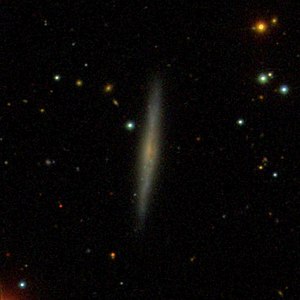IC 3099
| Galaxy IC 3099 |
|
|---|---|

|
|
| AladinLite | |
| Constellation | Virgin |
|
Position equinox : J2000.0 , epoch : J2000.0 |
|
| Right ascension | 12 h 17 m 09.3 s |
| declination | + 12 ° 27 ′ 15 ″ |
| Appearance | |
| Morphological type | Sbc / HII |
| Brightness (visual) | 14.2 mag |
| Brightness (B-band) | 14.9 mag |
| Angular expansion | 1.9 ′ × 0.3 ′ |
| Position angle | 172 ° |
| Surface brightness | 13.5 mag / arcmin² |
| Physical data | |
| Affiliation | Virgo cluster NGC 4168 group LGG 285 |
| Redshift | 0.007112 ± 0.000023 |
| Radial velocity | 2132 ± 7 km / s |
|
Stroke distance v rad / H 0 |
(93 ± 7) · 10 6 ly (28.4 ± 2.0) Mpc |
| history | |
| discovery | Arnold Schwassmann |
| Discovery date | September 14, 1900 |
| Catalog names | |
| IC 3099 • UGC 7313 • PGC 39390 • CGCG 069-126 • MCG + 02-31-079 • 2MASX J12170920 + 1227158 • VCC 224 • GALEX ASC J121709.37 + 122713.9 • USGC U472 NED01 • HOLM 360B • EVCC 269 | |
IC 3099 is a spiral galaxy with an active nucleus of the Hubble type Sc in the constellation Virgo on the ecliptic . It is estimated to be 93 million light years away from the Milky Way and has a diameter of around 55,000 ly. Together with IC 3100 and IC 3105 , it forms the galaxy trio Holm 160 . It is listed as a member of the Virgo galaxy cluster under the catalog name VCC 224 .
The galaxies IC 3078 , IC 3081 , IC 3137 , IC 3138 are located in the same area of the sky .
The object was discovered on September 14, 1900 by the German astronomer Arnold Schwassmann .
